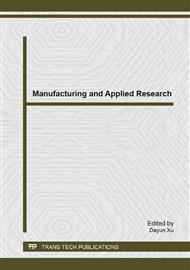p.83
p.88
p.91
p.95
p.100
p.107
p.112
p.117
p.121
Heat Treatment Recycling of Dual Phase Region and its Effect on Hardness, Microstructure and Corrosion Rate of Medium Carbon Steel
Abstract:
In this work, the investigations were carried out to study the effect of heat treatment at dual phase of austenite and ferrite on mechanical properties , microstructure and corrosion rate of low alloyed medium carbon steel. The specimens were divided into five groups, first group, specimens were heated to the duel phase region at temperature of 740°C soaked for 30 minutes and quenched in water. The second group, The specimens were heated to 740°C soaked for 30 minutes and quenched in water, then tempered to 480°C soaked for 20 minutes. The third group the specimens were heated to austenizing temperature of 840°C soaked for 30 minutes and quenched in water, then the specimens reheated to the dual phase region at 740°C, soaked for 30 minutes and quenched in water, then the specimens were tempered at temperature 480°C for 30 minutes. The forth group, the specimens were heated to austenizing temperature of 840°C soaked for 30 minutes and quenched in water, this process were repeated again before the specimens were thereafter heated to the dual phase region at temperature of 740°C, soaked for 20 minutes and quenched in water, then the specimens were tempered at temperature 480°C for 20 minutes. The fifth group, the specimens were heated to austenizing temperature of 840°C soaked for 20 minutes and quenched in water, this process were repeated two times again before the specimens were thereafter heated to the dual phase region at temperature of 740°C, soaked for 20 minutes and quenched in water, then the specimens finally tempered at temperature 480°C for 20 minutes. The results proved the hardness increase after heat treatment at first and second group, at third group the highest hardness value was due to formation of martensite and ferrite, but at fourth and fifth groups hardness decreases due to appearance of carbides particles, also corrosion rate usually increases with two phase at microstructure than stable one phase, third group have less corrosion rate than fourth and fifth due to carbides particles formation which lead to more corrosion rate due to three phases presents.
Info:
Periodical:
Pages:
100-104
Citation:
Online since:
March 2014
Authors:
Keywords:
Price:
Сopyright:
© 2014 Trans Tech Publications Ltd. All Rights Reserved
Share:
Citation:


